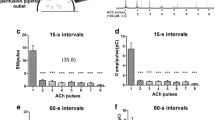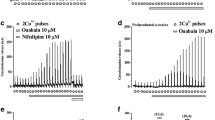Abstract
Intact bovine adrenal medullary chromaffin cells were preincubated with32PO4, and the multiplesite phosphorylation of tyrosine hydroxylase (TH) was studied. Up to eight32P-labeled peptides were produced by tryptic hydrolysis of TH; however, all of the tryptic phosphopeptides were derived from four phosphorylation sites—Ser8, Ser19, Ser31 and Ser40. In situ regulation of32P incorporation into the latter three sites was demonstrated with a diverse set of pharmacological agents.32P incorporation into Ser19 was preferentially increased by brief exposures to depolarizing secretagogues. Longer treatments also increased Ser31 and Ser40 phosphorylation. Nicotine, muscarine and vasoactive intestinal polypeptide—reflecting cholinergic and non-cholinergic components of sympatho-adrenal transmission—each produced different patterns of multiple-site phosphorylation of TH. Nicotine, bradykinin and histamine increased32P incorporation at each of the three sites whereas muscarine, angiotensin II, endothelin III, prostaglandin E1, GABA and ATP selectively increased Ser31 phosphorylation. Nerve growth factor did not influence TH phosphorylation in chromaffin cells from adult adrenal glands but selectively increased Ser31 phosphorylation in chromaffin cells isolated from calf adrenal glands.32P incorporation into Ser40 was selectively increased by forskolin and other cAMP-acting agents whereas vasoactive intestinal polypeptide increased Ser31 and Ser40 phosphorylation. Thus, the phosphorylation of TH in bovine chromaffin cells appears to be regulated at three sites by three separate intracellular signaling pathways—Ser19 via Ca2+/calmodulin-dependent protein kinase II; Ser31 via ERK (MAP2 kinases); and Ser40 via cAMP-dependent protein kinase. These signaling pathways, as well as the extracellular signals that were effective in stimulating them, are similar to those previously described for TH in rat pheochromocytoma cells. However, several of the pharmacological agents produced different patterns of multiple-site TH phosphorylation in the bovine chromaffin cells. These differences between tissues could be accounted for by differences in the coupling/access between the extracellular signal transduction systems and the intracellular signaling pathways as opposed to differences in the intracellular signaling pathwaysper se.
Similar content being viewed by others
References
Acheson, A., and Thoenen, H. 1987., Both short- and long-term effects of nerve growth factor on tyrosine hydroxylase in calf adrenal chromaffin cells are blocked by S-adenosylhomocysteine hydrolase inhibitors. J. Neurochem. 48:1416–1424.
Ahn, N. G., Robbins, D. J., Haycock, J. W., Seger, R., Cobb, M. H., and Krebs, E. G. 1992. Identification of an activator of the MAP kinases ERK1 and ERK2 in PC12 cells stimulated with nerve growth factor or bradykinin. J. Neurochem., 59:147–156.
Boulton, T. G., Nye, S. H., Robbins, D. J., Ip, N. Y., Radziejewska, E., Morgenbesser, S. D., DePinho, R. A., Panayotatos, N., Cobb, M. H., and Yancopoulos, G. D. 1991. ERKs: A family of protein-serine/threonine kinases that are activated and tyrosine phosphorylated in response to insulin and NGF. Cell 65:663–675.
Boulton, T. G., Yancopoulos, G. D., Gregory, J. S., Slaughter, C., Moomaw, C., Hsu, J., and Cobb, M. H. 1990. An insulinstimulated protein kinase similar to yeast kinases involved in cell cycle control. Science 249:64–67.
Cahill, A. L., Horwitz, J., and Perlman, R. L. 1989. Phosphorylation of tyrosine hydroxylase in protein kinase C-deficient PC12 cells. Neurosci. 30:811–818.
Campbell, D. G., Hardie, D. G., and Vulliet, P. R. 1986. Identification of four phosphorylation sites in the N-terminal region of tyrosine hydroxylase. J. Biol. Chem. 261:10489–10492.
Carmichael, S. W., and Stoddard, S. L. 1989. The Adrenal Medulla 1986–1988. Telford Press, Caldwell, N.J.
Challis, R. A. J., Jones, J. A., Owen, P. J., and Boarder, m. R. 1991. Changes in inositol 1,4,5-trisphosphate and inositol 1,3,4,5-tetrakisphosphate mass accumulations in cultured adrenal chromaffin cells in response to bradykinin and histamine. J. Neurochem. 56:1083–1086.
Chandler, C. E., Cragoe, E. J., and Glaser, L. 1985. Nerve growth factor does not activete Na+/H+ exchange in PC12 pheochromocytoma cells. J. Cell. Physiol. 125:367–378.
Cobb, M. H., Robbins, D. J., and Boulton, T. G. 1991. ERKs, extracellular signal-regulated MAP2 kinases. Curr. Opinion Cell Biol. 3:1025–1032.
D'Mello, S. R., Weisberg, E. P., Stachowiak, M. K., Turzai, L. M., Gioio A. E., and Kaplan, B. B. 1988. Isolation and nucleotide sequence of a cDNA clone encoding bovine adrenal tyrosine hydroxylase: Comparative analysis of tyrosine hydroxylase gene products. J. Neurosci. Res. 19:440–449.
Eipper, B. A., and Mains, R. E. 1982. Phosphorylation of proadrenocorticotropin/endorphin-derived peptides. J. Biol. Chem. 257:4907–4915.
Ely, C. M., Oddie, K. M., Litz, J. S., Rossomando, A. J., Kanner, S. B., Sturgill, T. W., and Parsons, S. J. 1990. A 42-kD tyrosine kinase substrate linked to chromaffin cell secretion exhibits an associated MAP kinase activity and is highly related to a 42-kD mitogen-stimulated protein in fibroblasts. J. Cell Biol. 110:731–742.
Funakoshi, H., Okuno, S., and Fujisawa, H. 1991. Different effects on activity caused by phosphorylation of tyrosine hydroxylase at serine 40 by three multifunctional protein kinases. J. Biol. Chem. 266:15614–15620.
George, R. J., Haycock, J. W., Johnston, J. P., Craviso, G. L., and Waymire, J. C. 1989. In vitro phosphorylation of bovine adrenal chromaffin cell tyrosine hydroxylase by endogenous protein kinases. J. Neurochem. 52:274–284.
Haavik, J., Schelling, D. L., Campbell, D. G., Andersson, K. K., Flatmark, T., and Cohen, P. 1989. Identification of protein phosphatase 2A as the major tyrosine hydroxylase phosphatase in adrenal medulla and corpus striatum: Evidence from the effects of okadaic acid. FEBS Lett. 251:36–42.
Haycock, J. W. 1987. Stimulation-dependent phosphorylation of tyrosine hydroxylase in rat corpus striatum. Brain Res. Bull. 19:619–622.
Haycock, J. W. 1989. Quantitation of tyrosine hydroxylase protein levels: Spot immunolabeling with an affinity-purified antibody. Anal. Biochem. 181:259–266.
Haycock, J. W. 1990. Phosphorylation of tyrosine hydroxylase in situ at serine 8, 19, 31 and 40. J. Biol. Chem. 265:11682–11691.
Haycock, J. W., Ahn, N. G., Cobb, M. H., and Krebs, E. G. 1992. ERK1 and ERK2, two microtubule-associated protein kinases, mediate the phosphorylation of tyrosine hydroxylase at serine 31 in situ. Proc. Natl. Acad. Sci. USA, 89:2365–2369.
Haycock, J. W., Bennett, W. F., George, R., and Waymire, J. C. 1982. Multiple-site phosphorylation of tyrosine hydroxylase: Differential regulation by 8-bromo-cAMP and acetylcholine. J. Biol. Chem. 257:13699–13703.
Haycock, J. W., Browning, M. D., and Greengard, P. 1988. Cholinergic regulation of protein phosphorylation in bovine adrenal chromaffin cells. Proc. Natl. Acad. Sci. USA 84:1677–1681.
Haycock, J. W., George, R. J., and Waymire, J. C. 1985. In situ phosphorylation of tyrosine hydroxylase in chromaffin cells: Localization to soluble compartments. Neurochem. Int. 7:301–308.
Haycock, J. W. and Haycock, D. A. 1991. Tyrosine hydroxylase in rat brain dopaminergic nerve terminals. Multiple-site phosphorylation in vivo and in synaptosomes. J. Biol. Chem. 266:5650–5657.
Haycock, J. W. and Wakade, A. R. 1992. Activation and multiplesite phosphorylation of tyrosine hydroxylase in perfused rat adrenal glands. J. Neurochem. 58:57–64.
Houchi, H., Oka, M., Misbahuddin, M., Morita, K., and Nakanishi, A. 1987. Stimulation by vasoactive intestinal polypeptide of catecholamine synthesis in isolated bovine adrenal chromaffin cells: Possible involvement of protein kinase C. Biochem. Pharmacol. 36:1551–1554.
Houghten, R. A. and Li, C. H. 1979. Reduction of sulfoxides in peptides and proteins. Anal. Biochem. 98:36–46.
Laemmli, U. K. 1970. Cleavage of structural proteins during the assembly of the head of bacteriophage T4. Nature (Lond.) 227:680–685.
Le Bourdelles, B., Horellou, P., Le Caer, J.-P., Denefle, P., Latta, M., Haavik, J., Guibert, B., Mayaux, J.-F., and Mallet, J. 1991. Phosphorylation of human recombinant tyrosine hydroxylase isoforms 1 and 2: An additional phosphorylated residue in isoform 2, generated through alternative splicing. J. Biol. Chem. 266:17124–17130.
Livett, B. G. 1984. Adrenal medullary chromaffin cells in vitro. Physiol. Rev. 64:1103–1161.
Livett, B. G., Mitchelhill, K. I., and Dean, D. M. 1987. Adrenal chromaffin cells—their isolation and culture. Pages 171–175,in Poisner, A. M. and Trifaro, J. M. (eds.), In Vitro Methods for Studying Secretion, Elsevier Science Publishers B. V., Amsterdam.
Malhotra, R. K., Wakade, A. R. 1987. Non-cholinergic component of rat splanchnic nerves predominates at low neuronal activity and is eliminated by naloxone. J. Physiol. (Lond.) 383:639–652.
Malhotra, R. K., Wakade, T. D., and Wakade, A. R. 1988. Vasoactive intestinal polypeptide and muscarine mobilize intracellular Ca2++ through breakdown of phosphoinositides to induce catecholamine secretion. J. Biol. Chem. 263:2123–2126.
Markwell, M. A. K., Haas, S. M., Bieber, L. L., and Tolbert, N. E. 1978. A modification of the Lowry procedure to simplify protein determination in membrane and lipoprotein samples. Anal. Biochem. 87:206–210.
Naujoks, K. W., Korsching, S., Rohrer, H., and Thoenen, H. 1982. Nerve growth factor-mediated induction of tyrosine hydroxylase and of neurite outgrowth in cultures of bovine adrenal chromaffin cells: Dependence on developmental stage. Dev. Biol. 92:365–379.
Negishi, M., and Ito, S. 1990. Involvement of phosphoinositide metabolism in GABA-induced catecholamine release from cultured bovine adrenal chromaffin cells. Biochem. Pharmacol. 40:2719–2725.
Negishi, M., Ito, S., and Hayaishi, O. 1989. Prostaglandin E receptors in bovine adrenal medulla are coupled to adenylate cyclase via Gi and to phosphoinositide metabolism in a pertussis toxin-insensitive manner. J. Biol. Chem. 264:3916–3923.
Plevin, R., and Boarder, M. R. 1988. Stimulation of formation of inositol phosphates in primary cultures of bovine adrenal chromaffin cells by angiotensin II, histamine, bradykinin and carbachol. J. Neurochem. 51:634–641.
Pocotte, S. L., and Holz, R. W. 1986. Effects of phorbol ester on tyrosine hydroxylase phosphorylation and activation in cultured bovine adrenal chromaffin cells. J. Biol. Chem. 261:1873–1877.
Saadat, S., Stehle, A. D., Lamouroux, A., Mallet, J., and Thoenen, H. 1988. Predicted amino acid sequence of bovine tyrosine hydroxylase and its similarity to tyrosine hydroxylases from other species. J. Neurochem. 51:572–578.
Sasakawa, N., Nakaki, T., and Kato, R. 1990. Stimulus-responsive and rapid formation of inositol pentakisphosphate in cultured adrenal chromaffin cells. J. Biol. Chem. 265:17700–17705.
Sasakawa, N., Nakaki, T., Yamamoto, S., and Kato, R. 1989. Stimulation by ATP of inositol triphosphate accumulation and calcium mobilization in cultured adrenal chromaffin cells. J. Neurochem. 52:441–447.
Smith, P. K., Krohn, R. I., Hermanson, G. T., Mallia, A. K., Gartner, F. H., Provenzano, M. D., Fujimoto, E. K., Goeke, N. M., Olson, B. J., and Klenk, D. C. 1985. Measurement of protein using bicinchoninic acid. Anal Biochem. 150:76–85.
Stauderman, K. A. and Pruss, R. M. 1990. Different patterns of agonist-stimulated increases of3H-inositol phosphate isomers and cytosolic Ca2+ in bovine adrenal chromaffin cells: Comparison of the effects of histamine and angiotensin II.. J. Neurochem. 54:946–953.
Swilem, A.-M. F., Hawthorne, J. N., and Azila, N. 1983. Catecholamine secretion by perfused bovine adrenal medulla in response to nicotinic activation is inhibited by muscarinic receptors. Biochem. Pharmacol. 32:3873–3874.
Tarr, G. E. 1987. Manual methods for protein/peptide sequence analysis. Pages 35–47, in Bhown, A. S. (ed.), “Protein/Peptide Sequence Analysis: Current Methodologies,” CRC Press, Inc., Boca Raton.
Vulliet, P. R., Woodgett, J. R., and Cohen, P. 1984. Phosphorylation of tyrosine hydroxylase by calmodulin-dependent multiprotein kinase. J. Biol. Chem. 259:13680–13683.
Wakade, T. D., Blank, M. A., Malhotra, R. K., Pourcho, R., and Wakade, A. R. 1991. The peptide VIP is a neurotransmitter in rat adrenal medulla: Physiological role in controlling catecholamine secretion. J. Physiol. (Lond.) 44:349–361.
Waymire, J. C., Bennett, W. F., Boehme, R., Hankins, L., Gilmer-Waymire, K., and Haycock, J. W. 1983. Bovine adrenal chromaffin cells: High yield purification and viability in suspension culture. J. Neurosci. Meth. 7:329–351.
Waymire, J. C., Craviso, G. L., Lichteig, K., Johnston, J. P., Baldwin, C., and Zigmond, R. E. 1991. Vasoactive intestinal peptide stimulates catecholamine biosynthesis in isolated adrenal chromaffin cells: Evidence for a cyclic AMP-dependent phosphorylation and activation of tyrosine hydroxylase. J. Neurochem. 57:1313–1324.
Waymire, J. C., Johnston, J. P., Hummer-Lickteig, K., Lloyd, A., Vigny, A., and Craviso, G. L. 1988. Phosphorylation of bovine adrenal chromaffin cell tyrosine hydroxylase. Temporal correlation of acetylcholine's effect on site phosphorylation, enzyme activation, and catecholamine synthesis. J. Biol. Chem. 263:12439–12447.
Wilson, S. P. 1988. Vasoactive intestinal peptide elevates cyclic AMP levels and potentiates secretion in bovine adrenal chromaffin cells. Neuropeptides 11:17–21.
Zigmond, R. E., Schwarzschild, M. A., and Rittenhouse, A. R. 1989. Acute regulation of tyrosine hydroxylase by nerve activity and by neurotransmitters via phosphorylation. Annu. Rev. Neurosci. 12:415–461.
Author information
Authors and Affiliations
Additional information
Special issue dedicated to Dr. Paul Greengard
Rights and permissions
About this article
Cite this article
Haycock, J.W. Multiple signaling pathways in bovine chromaffin cells regulate tyrosine hydroxylase phosphorylation at Ser19, Ser31, and Ser40 . Neurochem Res 18, 15–26 (1993). https://doi.org/10.1007/BF00966919
Accepted:
Issue Date:
DOI: https://doi.org/10.1007/BF00966919




